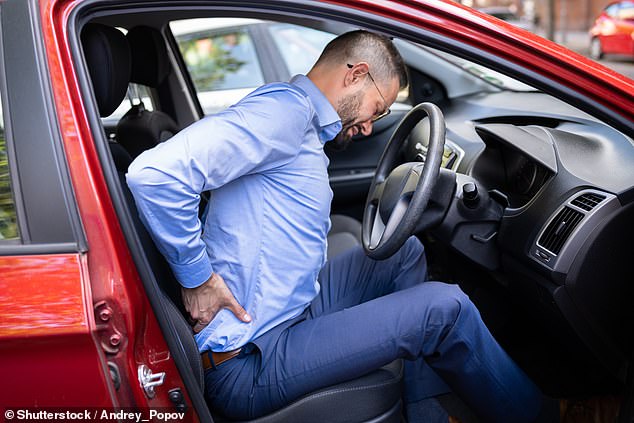Motorists are warned that failing to find an ideal driving position and, as a result, adopting a poor posture behind the wheel can trigger a variety of health problems in the future.
A physical therapist says it can not only lead to persistent headaches, hunched shoulders and muscle stiffness, but also cause long-lasting problems down the road.
Sammy Margo from Smartphysio Hampstead reveals five conditions linked to poor posture and the exercises you can do to combat them, while AutoTrader has outlined how you can adjust the position of your driver’s seat to avoid these problems.
Poor posture at the wheel can cause five health problems that could affect you in the future. We explain how to identify them and how a physiotherapist recommends treating them.
Sammy explains that driving can greatly affect posture, especially for those who spend long hours in the car when commuting to work or driving for a living.
The seated driving position can cause stiffness, muscle imbalances, reduced flexibility and great tension in the lower back.
To help combat this and ensure every ride is safe and comfortable, Sammy has broken down the top five health problems caused by poor posture:
1. Tension and discomfort in the neck and shoulders.
Sammy says: This can lead to chronic discomfort, muscle tension, and eventually stiffness and reduced range of motion.
2. Severe back pain
Sitting with an unsupported lower back can lead to muscle imbalances, as well as compression of the lumbar discs, muscle fatigue, and over time, the development of chronic lower back pain.
Lack of movement while driving can make this problem worse by reducing the natural lubrication and flexibility of the spinal joints.
3. Rounded shoulders and hunched neck
Rounded shoulders over long periods of time can lead to structural changes over time.
This can lead to reduced thoracic mobility, decreased lung capacity and increased stress on the cervical spine, making it more difficult to correct as these postural deviations become habitual.
4. Headaches and/or migraines
Forward head posture (which is common among drivers) can put tension on the muscles and nerves in the neck, leading to headaches.
Tension in the upper back and shoulders can also contribute to tension headaches.
5. Sciatica
Sciatica occurs when the sciatic nerve, which runs from the lower back down each leg, becomes compressed or irritated.
Poor driving posture can contribute to this by putting pressure on the lumbar spine or piriformis muscle, which can irritate the sciatic nerve.
How to adjust the driver’s seat to avoid bad posture
With modern cars equipped with seats with multiple adjustment options, there really is no excuse for drivers not to be able to find an optimal position.
To help you find yours, here are AutoTrader’s recommendations for finding your ideal setup:
Seat positioning: Adjust the seat so that your feet can comfortably reach the pedals with a slight bend in your knees. Your knees should be lower than or at hip level and your arms should be slightly bent at the elbows when holding the steering wheel.
Seat height: Your hips should be slightly higher than your knees to reduce pressure on your lower back. As a guide, make sure there is at least a fist-width of space between your head and the roof of the car.
Seat Angle: To reduce pressure on your lower back, tilt the seat back slightly until it is at a position between 100 and 110 degrees. Avoid reclining too much, as this can create a natural slouching shape that will add strain to your neck and shoulders.
Lumbar support: Many models now offer adjustable lumbar support, which you can adjust to the natural curve of your lower back. But if you don’t have one, you can purchase a lumbar cushion or a rolled towel that sits at the small of your back to prevent slouching.

Sitting with an unsupported lower back can lead to muscle imbalances, as well as compression of the lumbar discs, muscle fatigue, and over time, the development of chronic lower back pain.
Daily stretches to combat the first signs of posture-related health problems
If you notice your posture deteriorating or you feel uncomfortable while driving, Sammy says you can easily combat these early signs with simple daily exercises:

Sammy Margo from Smartphysio Hampstead outlines eight stretches and exercises you can do to reduce health problems caused by poor posture when driving
Chin Push-Ups: Slowly draw your chin towards your chest, as if you were trying to create a double chin. Hold this position for 10 seconds, relax and repeat the exercise a few times.
Upper Trapezius Stretch: Sit or stand with your back straight and gently tilt your head to one side as if pushing your ear towards your shoulder. Repeat the exercise on the other side.
Shoulder blade squeeze: Keeping your back straight, squeeze your shoulder blades together as if you were trying to hold a pencil between them and hold this position for five seconds before releasing.
Seated Hamstring Stretch: Sit on the edge of a chair with one leg extended and your heel flat on the floor. Keep your back straight and hinge your hips forward to stretch your hamstrings. Hold for 20 to 30 seconds on each leg.
Hip flexor stretch:Start in a lunge position with one foot forward and the other knee on the floor. Push your hips forward slightly while keeping your back straight to stretch the front of your hips. Hold for 20 to 30 seconds on each side.
Piriformis Stretch: Lie on your back with your knees bent. Cross one ankle over the opposite knee, then gently pull the uncrossed leg toward your chest, feeling a stretch in your glutes. Hold for 20 to 30 seconds on each side.
Bird-dog: This is a great exercise to strengthen your core. Start on all fours and extend one arm forward and the opposite leg back while working your core. Hold this position for 10 seconds before switching sides.
Pelvic tilts: Lie on your back with your knees bent and feet flat on the floor. Flatten your lower back against the floor by contracting your abdominal muscles and tilting your pelvis upward. Hold the position for five to ten seconds and then release.
Some links in this article may be affiliate links. If you click on them we may earn a small commission. This helps us fund This Is Money and keep it free to use. We do not write articles to promote products. We do not allow any commercial relationships to affect our editorial independence.

